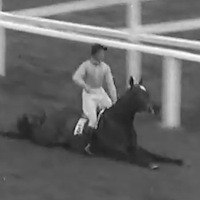Laika - The First Dog in Space

She was born, probably, on the streets of Moscow. She was a mongrel, possibly part-husky or Samoyed and part-terrier. Called Kudryavka at first, she was Muttnik to the American press. The world knows her as Laika, which just means “barker.” She was the first living being in space.
Laika was the cosmonaut aboard Sputnik 2, a satellite launched into orbit on November 3, 1957. To put this into perspective, Yuri Gagarin and Alan Shepard would not become the first humans in space until 1961.
By the mid-1950s, the Soviet Union was winning the space race, leaving the United States in a trail of cosmic dust. The Soviets had sent up Sputnik, the world’s first artificial satellite, in October, and it was emitting radio signals as it circled the globe. Its message, if not explicit, was clear: the USSR possessed the rocket power to launch guided missiles. The race was on.
It took only 29 days for the Russians to repeat their success. Laika (pronounced “lie-kah”) was 3 years old, and her mission was to determine if a living organism would survive space flight – including the launch itself! The first superpower to send a human into space would obviously prove superior, so Laika was duly volunteered. Harnessed in place, tucked between cushions under a heat shield, she shared her cabin with a device that absorbed carbon dioxide and generated oxygen, and a fan that kept the temperature below 59 degrees Fahrenheit. Food, which was half a gallon of a high-nutrition jelly, was within reach even during weightlessness.
Tragically, Laika died completing her mission.
A one-way trip
The mission had already incited outrage as well as awe, especially when, shortly after launch, the Soviets announced that Laika was not expected to return alive. She had been sent on a one-way trip. Her life-support system had been designed for a seven-day flight, but the technology hadn’t yet been invented for a return journey. That itself was objectionable, especially to animal-rights advocates. According to Time magazine, their objections prompted a Soviet official to respond: “The Russians love dogs. This has been done not for the sake of cruelty but for the benefit of humanity.”
Then, for more than 40 years, the official story maintained that Laika had remained alive for up to seven days before dying peacefully. Indeed, the plan had been to euthanize her with poisoned food before her oxygen supply ran out. However, the satellite had been designed too badly for the plan to succeed. Soviet Premier Nikita Krushchev had wanted it launched in time for the 40th anniversary of the Bolshevik Revolution, so Sputnik 2 had been a rush job. It was built within a mere month, and during space flight the cabin temperature ended up soaring above 100 degrees Fahrenheit.
According to Animals in Space, by Colin Burgess and Chris Dubbs, the capsule was designed not to separate from its rocket booster. This was an advantage for many reasons, including the ease with which the satellite could be tracked. However, Vladimir Yazdovskiy, a Sputnik 2 medical-team member, later admitted that they “didn’t take into account that the metal of the construction could bring more heat to the animal.” Laika died from excessive heat and stress. She had survived for only five to seven hours.
The truth
Laika’s story was finally revealed in 2002 by Dimitri Malashenkov, a Sputnik 2 scientist representing the Institute for Biomedical Problems in Moscow. Ostensibly, the benefit to humanity was knowledge of how living organisms react to conditions in space. Even five to seven hours was long enough to prove that a living organism could endure weightlessness. Yet is this really what justifies the sacrifice of her life? According to Burgess and Dubbs, the Soviet “satellite dog” program was spurred by the Eisenhower Administration’s promise to launch small satellites as early as 1955. So, really, Laika died for the cold war. In fact, Russian scientists had already sent dozens of animals, including monkeys and chimps, into space before trying to send one into orbit. Many animals suffered great distress. However, because Laika became a true pioneer of the space age, it was her death that sparked global debates over the ethics of space exploration.
Sputnik 2 fell back to Earth more than five months after launch, having circled the globe 2,570 times. To witnesses along the eastern U.S. coast, Laika’s coffin was a bluish-white streak across the sky that burned up and exploded into colorful flaming fragments before plunging into the ocean.
After her true story was divulged, Oleg Gazenko, who had selected and trained Laika, stated, “The more time passes, the more I am sorry about it. We did not learn enough from the mission to justify the death of a dog.” Still, Laika is a hero in Russia. Several monuments exist in her memory, including one unveiled in 2008 at her training facility. It depicts a dog poised on top of a rocket. Even NASA commemorated her in 2005, naming a patch of soil on Mars after the canine cosmonaut. Indeed, because she unknowingly bequeathed her own life to scientific progress, Laika should be honored every year on her last day of life, November 3.
Laika was the cosmonaut aboard Sputnik 2, a satellite launched into orbit on November 3, 1957. To put this into perspective, Yuri Gagarin and Alan Shepard would not become the first humans in space until 1961.
By the mid-1950s, the Soviet Union was winning the space race, leaving the United States in a trail of cosmic dust. The Soviets had sent up Sputnik, the world’s first artificial satellite, in October, and it was emitting radio signals as it circled the globe. Its message, if not explicit, was clear: the USSR possessed the rocket power to launch guided missiles. The race was on.
It took only 29 days for the Russians to repeat their success. Laika (pronounced “lie-kah”) was 3 years old, and her mission was to determine if a living organism would survive space flight – including the launch itself! The first superpower to send a human into space would obviously prove superior, so Laika was duly volunteered. Harnessed in place, tucked between cushions under a heat shield, she shared her cabin with a device that absorbed carbon dioxide and generated oxygen, and a fan that kept the temperature below 59 degrees Fahrenheit. Food, which was half a gallon of a high-nutrition jelly, was within reach even during weightlessness.
Tragically, Laika died completing her mission.
A one-way trip
The mission had already incited outrage as well as awe, especially when, shortly after launch, the Soviets announced that Laika was not expected to return alive. She had been sent on a one-way trip. Her life-support system had been designed for a seven-day flight, but the technology hadn’t yet been invented for a return journey. That itself was objectionable, especially to animal-rights advocates. According to Time magazine, their objections prompted a Soviet official to respond: “The Russians love dogs. This has been done not for the sake of cruelty but for the benefit of humanity.”
Then, for more than 40 years, the official story maintained that Laika had remained alive for up to seven days before dying peacefully. Indeed, the plan had been to euthanize her with poisoned food before her oxygen supply ran out. However, the satellite had been designed too badly for the plan to succeed. Soviet Premier Nikita Krushchev had wanted it launched in time for the 40th anniversary of the Bolshevik Revolution, so Sputnik 2 had been a rush job. It was built within a mere month, and during space flight the cabin temperature ended up soaring above 100 degrees Fahrenheit.
According to Animals in Space, by Colin Burgess and Chris Dubbs, the capsule was designed not to separate from its rocket booster. This was an advantage for many reasons, including the ease with which the satellite could be tracked. However, Vladimir Yazdovskiy, a Sputnik 2 medical-team member, later admitted that they “didn’t take into account that the metal of the construction could bring more heat to the animal.” Laika died from excessive heat and stress. She had survived for only five to seven hours.
The truth
Laika’s story was finally revealed in 2002 by Dimitri Malashenkov, a Sputnik 2 scientist representing the Institute for Biomedical Problems in Moscow. Ostensibly, the benefit to humanity was knowledge of how living organisms react to conditions in space. Even five to seven hours was long enough to prove that a living organism could endure weightlessness. Yet is this really what justifies the sacrifice of her life? According to Burgess and Dubbs, the Soviet “satellite dog” program was spurred by the Eisenhower Administration’s promise to launch small satellites as early as 1955. So, really, Laika died for the cold war. In fact, Russian scientists had already sent dozens of animals, including monkeys and chimps, into space before trying to send one into orbit. Many animals suffered great distress. However, because Laika became a true pioneer of the space age, it was her death that sparked global debates over the ethics of space exploration.
Sputnik 2 fell back to Earth more than five months after launch, having circled the globe 2,570 times. To witnesses along the eastern U.S. coast, Laika’s coffin was a bluish-white streak across the sky that burned up and exploded into colorful flaming fragments before plunging into the ocean.
After her true story was divulged, Oleg Gazenko, who had selected and trained Laika, stated, “The more time passes, the more I am sorry about it. We did not learn enough from the mission to justify the death of a dog.” Still, Laika is a hero in Russia. Several monuments exist in her memory, including one unveiled in 2008 at her training facility. It depicts a dog poised on top of a rocket. Even NASA commemorated her in 2005, naming a patch of soil on Mars after the canine cosmonaut. Indeed, because she unknowingly bequeathed her own life to scientific progress, Laika should be honored every year on her last day of life, November 3.
You Should Also Read:
Yuri Gagarin is the First Person in Space
Neil Armstrong - First Man on the Moon
NASA Chooses Four New Female Astronauts

Related Articles
Editor's Picks Articles
Top Ten Articles
Previous Features
Site Map
Content copyright © 2023 by Lane Graciano. All rights reserved.
This content was written by Lane Graciano. If you wish to use this content in any manner, you need written permission. Contact Lane Graciano for details.







